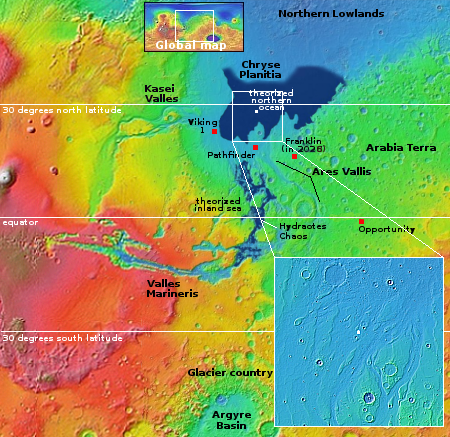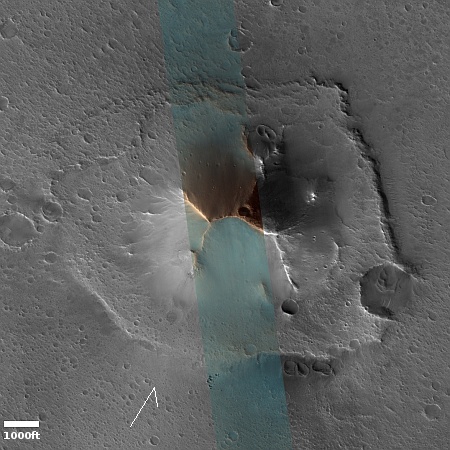A pointy mesa once washed by theorized Martian ocean
Today’s cool image returns to the same region yesterday’s cool image visited. The picture to the right, cropped, reduced, and sharpened to post here, was taken on July 21, 2024 by the high resolution camera on Mars Reconnaissance Orbiter (MRO). It was clearly taken to get a close look at this unusual pointy mesa.
MRO elevation data says this mesa is about 800 feet height. The color difference between the north and south flanks suggests the accumulated presence of dust on the north, suggesting the prevailing winds here come from the northeast and blow to the southwest. This conclusion is reinforced by the dark accumulated dust found in the southwest quadrants of all the crater floors in the full image. The wind blows this dust into the craters, where it gets trapped against the southwest crater wall.
Note the mesa’s wide base, with one crater partly eaten away on its eastern edge. The overall shape of this base suggests that it was carved by some flow coming from the southwest, as indicated by the arrow.

The white dot on the overview map to the right marks the location, deep within a region where some scientists believe a shallow and short-lived ocean once existed. That ocean is theorized to have been the run off from the catastrophic floods that poured out from Valles Marineris and other parallel channels, such as Ares and Kasei Vallis.
In the inset you can see how all the major plateaus in this region have scalloped shapes, as if water had flowed past quickly from the southwest to the northeast. A comparison however with the scalloped features from yesterday’s cool image suggests to me that the speed of the flow was less in today’s region. In other words, we are possibly looking at the effects of the slow underwater currents in that shallow ocean.
Why is the mesa pointy however? Normally buttes such as this have flat tops, indicating the surface elevation before erosion washed away the surrounding terrain. This mesa’s pointy peaks suggest maybe the erosion was more aggressive at this location, maybe because the mesa itself might have been underwater in that theorized ocean.
On Christmas Eve 1968 three Americans became the first humans to visit another world. What they did to celebrate was unexpected and profound, and will be remembered throughout all human history. Genesis: the Story of Apollo 8, Robert Zimmerman's classic history of humanity's first journey to another world, tells that story, and it is now available as both an ebook and an audiobook, both with a foreword by Valerie Anders and a new introduction by Robert Zimmerman.
The print edition can be purchased at Amazon or from any other book seller. If you want an autographed copy the price is $60 for the hardback and $45 for the paperback, plus $8 shipping for each. Go here for purchasing details. The ebook is available everywhere for $5.99 (before discount) at amazon, or direct from my ebook publisher, ebookit. If you buy it from ebookit you don't support the big tech companies and the author gets a bigger cut much sooner.
The audiobook is also available at all these vendors, and is also free with a 30-day trial membership to Audible.
"Not simply about one mission, [Genesis] is also the history of America's quest for the moon... Zimmerman has done a masterful job of tying disparate events together into a solid account of one of America's greatest human triumphs."--San Antonio Express-News
Today’s cool image returns to the same region yesterday’s cool image visited. The picture to the right, cropped, reduced, and sharpened to post here, was taken on July 21, 2024 by the high resolution camera on Mars Reconnaissance Orbiter (MRO). It was clearly taken to get a close look at this unusual pointy mesa.
MRO elevation data says this mesa is about 800 feet height. The color difference between the north and south flanks suggests the accumulated presence of dust on the north, suggesting the prevailing winds here come from the northeast and blow to the southwest. This conclusion is reinforced by the dark accumulated dust found in the southwest quadrants of all the crater floors in the full image. The wind blows this dust into the craters, where it gets trapped against the southwest crater wall.
Note the mesa’s wide base, with one crater partly eaten away on its eastern edge. The overall shape of this base suggests that it was carved by some flow coming from the southwest, as indicated by the arrow.

The white dot on the overview map to the right marks the location, deep within a region where some scientists believe a shallow and short-lived ocean once existed. That ocean is theorized to have been the run off from the catastrophic floods that poured out from Valles Marineris and other parallel channels, such as Ares and Kasei Vallis.
In the inset you can see how all the major plateaus in this region have scalloped shapes, as if water had flowed past quickly from the southwest to the northeast. A comparison however with the scalloped features from yesterday’s cool image suggests to me that the speed of the flow was less in today’s region. In other words, we are possibly looking at the effects of the slow underwater currents in that shallow ocean.
Why is the mesa pointy however? Normally buttes such as this have flat tops, indicating the surface elevation before erosion washed away the surrounding terrain. This mesa’s pointy peaks suggest maybe the erosion was more aggressive at this location, maybe because the mesa itself might have been underwater in that theorized ocean.
On Christmas Eve 1968 three Americans became the first humans to visit another world. What they did to celebrate was unexpected and profound, and will be remembered throughout all human history. Genesis: the Story of Apollo 8, Robert Zimmerman's classic history of humanity's first journey to another world, tells that story, and it is now available as both an ebook and an audiobook, both with a foreword by Valerie Anders and a new introduction by Robert Zimmerman.
The print edition can be purchased at Amazon or from any other book seller. If you want an autographed copy the price is $60 for the hardback and $45 for the paperback, plus $8 shipping for each. Go here for purchasing details. The ebook is available everywhere for $5.99 (before discount) at amazon, or direct from my ebook publisher, ebookit. If you buy it from ebookit you don't support the big tech companies and the author gets a bigger cut much sooner.
The audiobook is also available at all these vendors, and is also free with a 30-day trial membership to Audible.
"Not simply about one mission, [Genesis] is also the history of America's quest for the moon... Zimmerman has done a masterful job of tying disparate events together into a solid account of one of America's greatest human triumphs."--San Antonio Express-News


